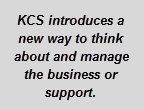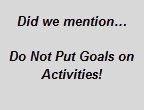Summary
KCS is not something we do in addition to solving problems. It becomes the way we solve problems.
In order for our service organizations to deliver higher value to our customers, we must focus on the source of value: people and knowledge. We must transition from a call-centric, transaction-oriented model to a knowledge-centric, relationship-based model. We must recalibrate our measurement systems to measure the creation of value, not just activity. We must rethink the role of information, knowledge workers, managers, and customers to take full advantage of the knowledge that emerges from the experience and interactions of the service and support organization.
KCS requires many changes in an organization, and Consortium members have demonstrated the great benefits that emerge. In this guide, we have attempted to capture the best we know to date on the techniques for embracing the core practices that make up KCS. These practices, organized in the individual-focused Solve Loop and the team-focused Evolve Loop, represent the essence of KCS—sharing and reusing knowledge to create value for the organization.
- Solve Loop
- Capture
- Structure
- Reuse
- Improve
- Evolve Loop
- Content Health
- Process Integration
- Performance Assessment
- Leadership & Communication
As we work to adopt KCS, we usually discover that many mental shifts are happening. The way we think about our efforts and those of the group change:
- Focus on knowledge rather than experience.
- Emphasize Knowledge-Centered Service over knowledge engineering.
- Knowledge is best managed at the point of creation, in the context of demand.
- Linear, production line processes become a collaborative, knowledge-enabled network.
- Emphasize just-in-time review over just-in-case creation.
- Take individual ownership of actions and performance and have collective ownership of the knowledge base.
- Look to managers for leadership and motivation rather than direction and instruction.
Lessons Learned
During adoption, we often over-engineer workflows and content standards. They become too complicated and cumbersome. We also spend too much time converting legacy data rather than creating KCS articles. This overhead slows down and demoralizes the participants, who are often eager to embrace new areas of knowledge and practice their newfound KCS skills. We should not dwell on the laggards who might be resisting change, but reinforce the success of the early adopters through positive support.
 Other proven success factors make a difference in KCS adoption. Perhaps the most obvious and visible one is executive sponsorship. Executives need to populate the strategic framework with goals that support the KCS workflow. They need to fund the infrastructure and resources and maintain support for the team while communicating (in a sustained way) the benefits, strategic impact, and progress of the KCS program. These communications, across their peers, upward to senior management, and downward to the team, provide leadership and motivate the team.
Other proven success factors make a difference in KCS adoption. Perhaps the most obvious and visible one is executive sponsorship. Executives need to populate the strategic framework with goals that support the KCS workflow. They need to fund the infrastructure and resources and maintain support for the team while communicating (in a sustained way) the benefits, strategic impact, and progress of the KCS program. These communications, across their peers, upward to senior management, and downward to the team, provide leadership and motivate the team.
Communication from executives and within the team should be part of a formal program to help each stakeholder group—the requestors, responders, and organization—understand and support the transition. Glitches and ditches are common, and communications help manage expectations, overcome objections, and deal with exceptions. Audience-appropriate messaging through multiple communication avenues will smooth adoption and help people understand, "What's in it for me?" Do not let the communications plan be too short or superficial—communications are central to change management and need to be both thoughtful and sustained to have a real impact.
The coaching role, new to many teams, has an enormous effect. When the right people are selected (ideally, by their peers) and given the time and support to coach, KCS prospers. Coaches must have strong interpersonal and influence skills as well as an operational understanding of the KCS practices.
 The right metrics are based on goals for the outcomes or results and enable trend analysis for the leading indicators or activities. Do not put goals on activities. Through the strategic framework, we empower and motivate knowledge workers (and managers) with a clear association of their individual activities to organizational goals. A balanced view of the metrics and trend analysis should enable continuous improvement and performance assessment.
The right metrics are based on goals for the outcomes or results and enable trend analysis for the leading indicators or activities. Do not put goals on activities. Through the strategic framework, we empower and motivate knowledge workers (and managers) with a clear association of their individual activities to organizational goals. A balanced view of the metrics and trend analysis should enable continuous improvement and performance assessment.
Performance assessment should focus on the creation of value by individuals and teams. It must consider both qualitative and quantitative measures and reinforce the transition from an activity-based model to a value-based model.
Another important mental shift is the attitude about the KCS deployment. The team and its enablers and stakeholders must see KCS as an organizational change, not just a tool. KCS can be assisted by technology, but is dependent far more on the changes in organizational values, interactions, and processes. Knowledge management and KCS are about people, not technology. They offer a new way to think about and manage the business of support.
The adoption of KCS inevitably changes the nature of interaction between the levels or tiers in the traditional support model. The distinction between support levels should diminish, creating a sense of one team aligned to a common purpose.
It's a Matter of Balance
As we said in the introduction, the adoption of KCS represents a transformation. It requires a shift in the organization's culture, values, and focus. It requires a balance of:
Individual and Team
Activity and Outcome
Completion and Evolution
Content and Context
Knowing and Learning
Management and Leadership
We hope this guide has helped launch you your KCS journey. KCS adoption is not a trivial undertaking. It requires both patience and persistence; change is hard!
The KCS v6 Practices Guide reflects the collective experience and thinking of the many dedicated individuals and organizations who make up the Consortium for Service Innovation, as well as the academic work reflected here. We continue to learn and evolve our understanding. The evolution is a function of our members' courage to try new and therefore unproven ways to address the challenges of change. If you like what you see in the KCS Practices and would like to contribute to its ongoing evolution, please join us. The journey continues!
